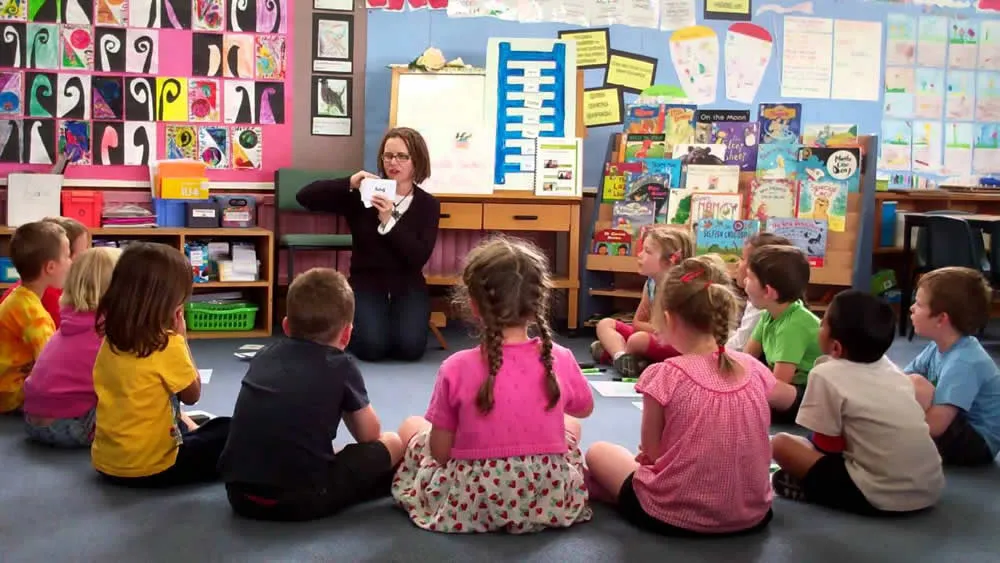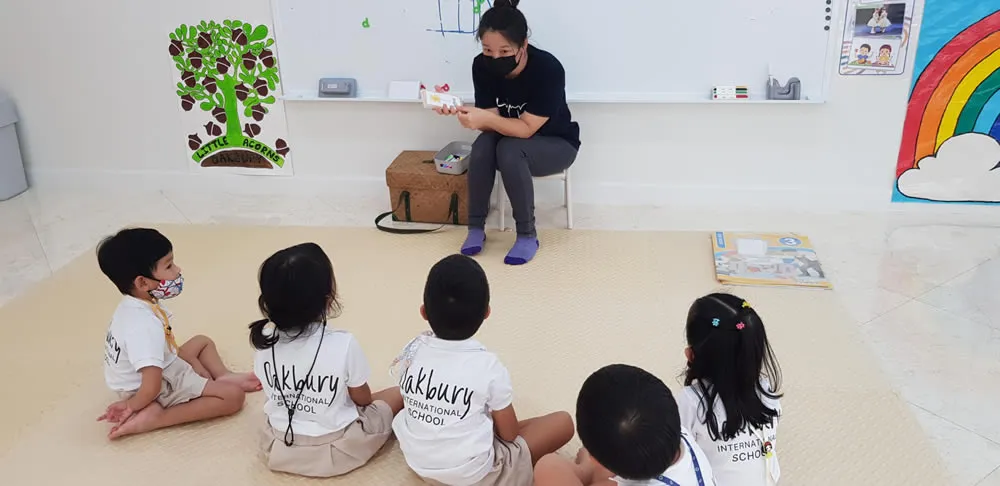
Source: cdnparenting
The ability to read and write is essential for the smooth learning process. Yet, many children and adults alike grapple with literacy challenges. One potent tool that can significantly bridge this gap is “Phonic Training”. This method is not just about memorizing the alphabet or parroting words. Instead, Phonic Training equips learners with a foundational understanding of how sounds relate to letters and words.
Here’s a brief glimpse of what this blog will cover:
Sound and Sense
How phonics establishes a connection between sounds (phonemes) and their written symbols (graphemes).
Early Learning Boost
The benefits of introducing Phonic Training at a young age, ensuring children have a head-start in their reading journey.
Tailored Techniques
Highlighting adaptable strategies that cater to individual learning paces and styles, ensuring no one feels left behind.
Beyond English
Demonstrating that while phonics is often associated with the English language, its principles can be applied to other languages as well, enhancing linguistic versatility.
Let us explore the transformative power of Phonic Training and its role in enhancing literacy and lifelong learning.

Source: wordunited
Benefits of Teaching Phonics
Phonics Course is the bridge between the English language’s letters and their sounds, making the journey of learning smoother.
Benefits of Teaching Phonics:
Clarity in Sounds
Phonic Training demystifies the sounds each letter represents.
Strengthens Reading Capabilities
Armed with the knowledge of sounds, reading words becomes second nature.
Empowers Spellers
Through sound recognition, children can easily break down and spell words.
Balanced Language Growth
Phonic Training ensures simultaneous development in reading, writing, and spelling.
A Tested Strategy
The emphasis on letter sounds has been shown to yield positive outcomes time and again.
Career Scope for Phonics Teacher
With Phonic Training, especially guided by the Vidhyanidhi Education Society (VES), the sky’s the limit in terms of career Career Scope for Phonics Teacher.
Explore the spectrum of opportunities awaiting a seasoned phonics teacher:
- Pave the way by rolling out home-centric phonics courses, balancing minimal expenses with lucrative returns.
- Stand out as a tuition mentor by introducing phonics as a standout subject.
- Capitalize on the steady demand for phonics mavens in primary and kindergarten school sectors.
- Amplify your potential and reach within the academic circles by championing phonics as a regular school teacher.
- Elevate global teacher training frameworks by stepping in as a master phonics instructor.
- Craft the future of phonics as a curriculum sculptor or an academic content maestro in global establishments.
- Elevate decision-making roles, overseeing academic institutions or creative hubs, leveraging your phonics knowledge.
- Champion the cause of children with unique learning needs as a dedicated phonics guide or therapy teacher.
- As a trained phonics instructor, not only transform your career but also sculpt the linguistic foundations of your children.
Reach our course guide for clarity: +919869546913 / +919869866277.
The brochure is just a Click Away!
Online Phonics Training Letters and Sounds
Vidhyanidhi Education Society is the premier destination for Online Phonic Training Letters and Sounds in India.
Distinct features of our online Phonic Training include:
- Enrollment is open all year.
- Value for money course structure.
- Simple Phonic Training registration mechanism.
- Open to participants worldwide.
- Connect with just an internet link.
- Clear course outline.
- Thorough study materials are available in a handy format.
- Resources include an instructor’s guide, varied worksheets, illustrative flashcards, and multimedia supplements.
- Stimulating virtual classes.
- Trained professional instructors.
- Gentle grading system.
- Neutral certificate design.
- Prompt certificate dispatch.
- Certificate holds international prestige.

Source: ytimg
Syllabus for Phonics Teacher Training Course
Our experts have built a Syllabus for Phonics Teacher Training Course after thorough evaluations, encompassing:
- Defining Phonics
- Exploring the Phonic Training Landscape
- Advantages of Phonics against the Whole Language Approach
- Letter Sounds and Formation Basics
- Blending and Segmenting techniques
- Insights into Consonant Blends
- Digraph Sounds Explained
- Distinctions between Digraphs and Blends
- Navigating Tricky Vocabulary
- Adhering to Phonics Protocols
- Various Vowel Sounds and Corresponding Spellings.
Structure of Phonics Teachers Training Course
The Structure of Phonics Teachers Training Course at VES offers a hassle-free and efficient pathway for aspiring teachers:
- Initiate communication with us
- Grasp what we offer
- Become a member
- Be present for Phonic Training
- Undertake the evaluation
- Be awarded your certificate
- Enter the world of Phonics Course teaching
- Time for joy!
Duration of Phonic Training
The six-day Duration of Phonic Training provides 3-hour daily sessions, making up a total of 18 hours.
Eligibility for Phonic Training
One has the Eligibility for Phonic Training if they have a basic grasp of the English language.
Phonics Course Teacher Salary
Phonics Teacher Salary is contingent upon the paying policies of the school, its locality, the instructor’s adeptness, and current market evaluations. With proper Phonic Training credentials, reaching a five-figure paycheck is achievable.
Phonics Course Fees
If you’re looking for value, VES’s Phonics Course Fees are priced just right. Plus, the availability of multiple discounts and easy payment options is a bonus.
How to Teach CVC Words to First Graders?
Teaching CVC (consonant-vowel-consonant) words to first graders is foundational in helping them become fluent readers. CVC words are typically one-syllable words that follow a pattern of a consonant, followed by a vowel, and ending with another consonant (e.g., cat, dog, run).
Here are some strategies and steps on How to Teach cvc Words to First Graders:
Start with Phonemic Awareness
Use activities that teach kids to recognize and produce rhymes.
Segment and blend sounds (phonemes) in simple CVC words. For instance, ask the students to break apart the sounds in “cat” (/c/ /a/ /t/) and then blend them back together.
Introduce CVC Words Systematically
Start with short “a” words like “cat,” “bat,” “rat,” and then move on to other vowel sounds.
Use word families. For instance, teach the “-at” family (cat, hat, sat, mat, rat, etc.) before moving on to another family, like “-og” (dog, log, fog).
Use Multisensory Approaches
Make use of magnetic letters or letter tiles to create words.
Let students write CVC words in sand, shaving cream, or on chalkboards to engage multiple senses.
Incorporate Visual Aids
Flashcards can be effective. One side of the card can have the CVC word and the other side can have a corresponding picture.
Draw pictures or have students illustrate the words they learn.
Play Games
Games like “I Spy” can be played using CVC words.
Memory match games where students match a CVC word to its picture.
Bingo games using CVC words.
Practice Reading and Writing
Read simple books with CVC words. Encourage students to point and read out loud.
Have students practice writing CVC words or use them in sentences.
Reinforce with Repetition
Repeated exposure is key. Read CVC words daily and offer plenty of opportunities for practice in different contexts.
Use Technology
There are numerous apps and online games that focus on phonics and CVC words. These can be fun and entertaining for students.
Assess and Review
Regularly check students’ understanding and recall of CVC words.
Use assessments to inform your instruction. If students are struggling with certain word families or patterns, spend more time on those.
Connect to Real Life
Whenever possible, connect the CVC words to real objects or actions in the students’ lives. For example, when learning the word “dog,” you might ask if any students have dogs and what their dogs’ names are.
Introduce Word Blends Gradually
Once students are comfortable with basic CVC words, you can introduce blends (e.g., “pl” in “plug” or “dr” in “drop”).
Stay Positive and Encouraging
It can be challenging for some students to learn to read. Laud their victories, no matter how small, and provide positive support.
Remember, the goal is to make learning CVC words fun, engaging, and relevant for first graders. Regular practice, coupled with varied instructional methods, will help solidify their understanding and ability to read and use these words effectively.

Source: oakbury
Reach our course guide for clarity: +919869546913 / +919869866277.
The brochure is just a Click Away!
How to Teach ee and ea Sounds?
Teaching the “ee” and “ea” sounds can be an essential component of early literacy education since they often represent the same vowel sound.
Here are steps and strategies on How to Teach ee and ea Sounds:
Introduce with a Story or Rhyme
Start by introducing a memorable story or rhyme. For example, “When ‘e’ and ‘a’ are seated together, they often say ‘ee’ like in ‘beak’. When ‘e’ and ‘e’ sit together, they always say ‘ee’ like in ‘tree’.”
Visual Aids
Use picture cards to show words with “ee” and “ea”.
Examples:
For “ee”: tree, bee, knee, sleep
For “ea”: sea, tea, leaf, beach
Word Sort
Give students a list of words and have them sort them into two groups based on whether they contain “ee” or “ea”.
Use Color Coding
When writing words on the board or paper, color code the “ee” and “ea” sounds. This helps students visually recognize the patterns.
Highlight Frequency
Note that while both “ee” and “ea” can make the same sound, they appear in different contexts. The “ee” is often found in the middle or end of words, while “ea” can be found at the beginning, middle, or end.
Reading Practice
Choose books or texts that frequently use “ee” and “ea” words. Have students read aloud and emphasize recognizing and sounding out these patterns.
Rhyming Words
Introduce rhyming words. For example, “bee” rhymes with “tree” and “see” rhymes with “tea”. This helps reinforce the sound pattern.
Fill in the Blanks
Create sentences where students have to fill in the blank with either an “ee” or “ea” word.
Example: “It was a pleasure to ___ you.” (Probable answers: meet, see)
Word Families
Focus on specific word families, like “-eep” and “-eat”. List words that fit into each family: sheep, keep, sleep; and meat, seat, treat.
Games and Activities
Engage students with games like Bingo, memory matching, or crossword puzzles that focus on “ee” and “ea” words.
Exceptions and Variations
Point out exceptions. Not every “ea” word has the “ee” sound. For example, “bread” and “steak” don’t have the same vowel sound as “beach” and “tea”. Discuss these differences to make students aware.
Spelling Practice
Provide spelling lists and tests that focus on “ee” and “ea” words. This reinforces both the phonetic and orthographic patterns.
Use Songs and Chants
There are many phonics songs and chants available that emphasize vowel teams, including “ee” and “ea”. Singing can make learning more engaging and memorable.

Source: landmarkschool
Continuous Review
Periodically revisit the “ee” and “ea” sounds to reinforce their learning. Spaced repetition can help students commit these patterns to long-term memory.
Remember, every student is different. Some might grasp these vowel teams quickly, while others might need more practice. Manipulate your teaching techniques based on the needs of the students.
How to Teach Phonics Montessori?
Teaching phonics using the Montessori method emphasizes a multisensory and systematic approach.
Here’s a basic overview of How to Teach Phonics Montessori way:
Preparation & Environment
Have a well-organized, quiet, and distraction-free environment for the child to work in.
Montessori materials should be accessible to the child.
For phonics, this means having Sandpaper Letters, Moveable Alphabets, and other materials within reach.
Start with Phonemic Awareness
Engage in activities that highlight the sounds in words. For example, play I-Spy with sounds: “I spy with my little eye, something that starts with the ‘s’ sound.”
Play rhyming games, segmenting, and blending games without any visual aids.
Introduce Sandpaper Letters
These are tactile letters that children can trace with their fingers while saying the sound out loud. This is a perfect combination of auditory, visual, and kinesthetic learning.
Always focus on the phonetic sounds of the letters, not their names. For example, ‘a’ should be “a” as in apple, not “ay”.
Three-period Lesson
Montessori phonics often employs the three-period lesson approach:
Introduction- (“This is”): Demonstrate the letter and its sound.
Association- (“Show me”): Ask the child to pick or point out the letter after hearing its sound.
Recall- (“What is this?”): Show a letter and ask children to read the letter aloud.
Moveable Alphabet
Once children are familiar with several letter sounds, introduce the Moveable Alphabet. This is a set of letters that children can manipulate to form words.
Begin by constructing phonetic three-letter words. Encourage the child to sound out and read the words they form.
Blending Activities
Use simple tools like a blending slider or word lists to practice blending.
Move from CVC (consonant-vowel-consonant) words like “cat” and “dog” to more complex words as the child progresses.
Introduce Phonograms
After mastering basic phonetic sounds, introduce phonograms like “sh”, “ch”, “th”, and others using similar techniques.
Word Lists & Reading
Create or source Montessori-compatible word lists that can help children practice their phonics skills. This can progress from simple phonetic words to lists that include phonograms.
Introduce beginner-level Montessori-friendly books. Allow children to read aloud, sounding out words as they go.
Grammar & Function of Words
As the child becomes more proficient, introduce basic grammar concepts using Montessori grammar symbols. For example, a large black triangle represents a noun, and a small red circle represents an article.
Continue to Engage with Real-Life Situations
Encourage children to read labels, signs, and other prints they encounter in their environment.
Read to them regularly and discuss the sounds, words, and grammar in the context of the story.
Remember, the Montessori method emphasizes following the child’s pace. Some children may quickly grasp phonics concepts, while others might need more repetition and practice. Always approach lessons with patience and a keen observation of the child’s readiness and interest.
Elevate your teaching skills, the Vidhyanidhi way!
Reach our course guide for clarity: +919869546913 / +919869866277.
The brochure is just a Click Away!
FAQs
What are the Letter Sounds?
Letter sounds are the individual sounds each letter makes, essential for reading and phonics, e.g., 'a' in an apple or 'b' in a ball.
How to teach Letter Sound correspondence?
To teach letter-sound correspondence: Introduce one sound at a time, use visuals & repetition. VES's Online Phonics Program offers innovative methods for effective teaching.
How to make learning Phonics fun?
Make learning Phonics fun: Engage students using games, songs, stories, and hands-on activities and make lessons memorable. Ask them to make the sound of the letter displayed.



